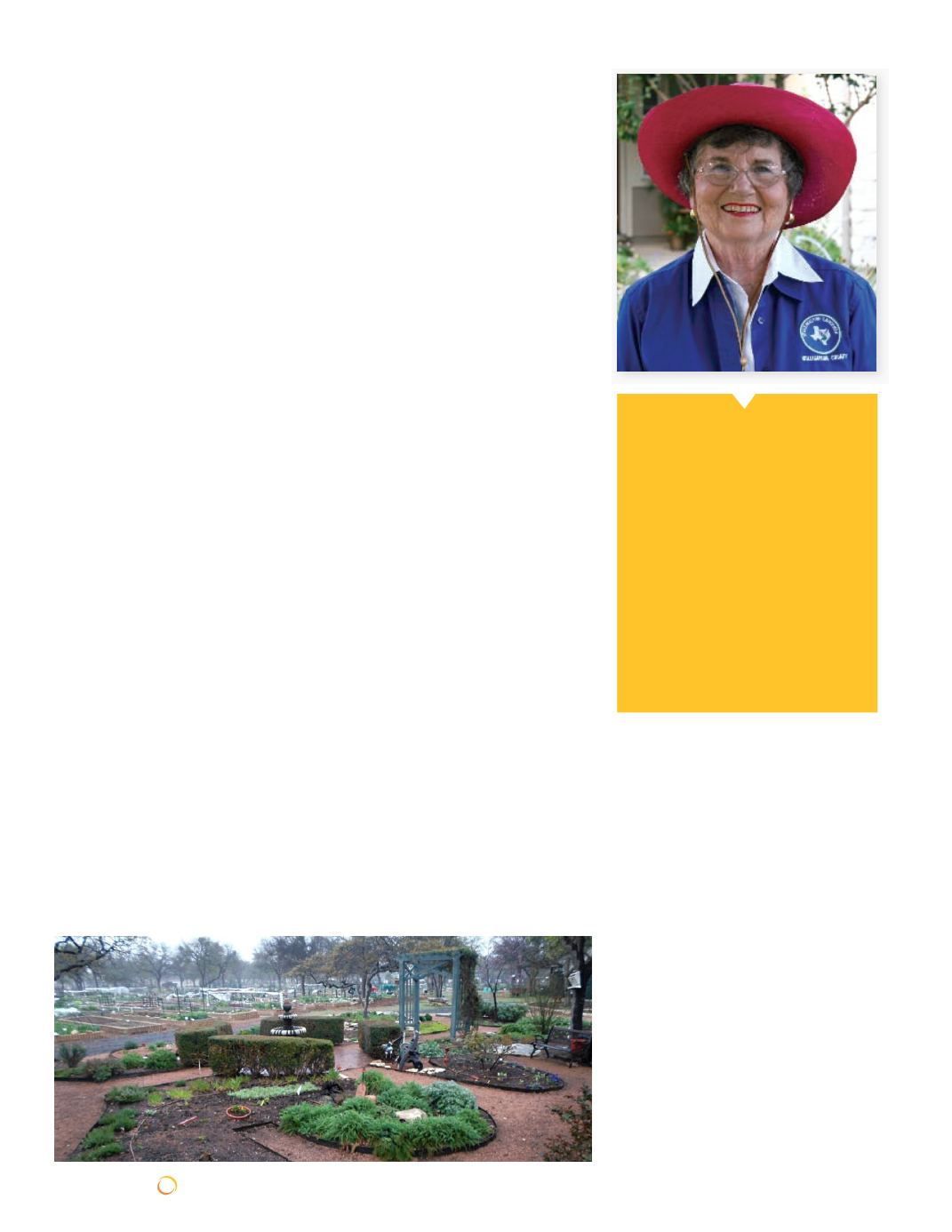
66
| SUNRAYS MAY 2015
ONLINE:
SCTEXAS.ORG
Alone or in any style garden, herbs
offer so many lovely possibilities, most
aromatic and many delicious! The photo
shown here is of the beautiful herb
garden in the front of the Horticulture
Club Gardens. Feel free to view in person
any Thursday or Saturday morning 9
a.m. to 11 a.m. while the nursery is open
selling plants and mulch.
Herbs! The word itself excites gardeners,
craftsmen and chefs alike, offering
numerous textures, colors and flavors
for endless joy! My gardening mentor,
Madalene Hill, co-author of
Southern
Herb Growing
, with her daughter, Gwen
Barclay, defined herbs as any plant that
has or has had a use - that certainly
broadens the field!
Bees, butterflies and other beneficial
insects are attracted to herbs, and herbs
have been used through history to keep
away harmful insects. Leaves, seeds and
roots can be used as flavoring agents.
Dill not only lends a refreshing oomph
to seafood and other sauces but also is a
traditional ingredient in many pickling
recipes. Not only can most herbs be
grown year round (particularly relevant
to Central Texas), but with only a few
exceptions, deer avoid them. Hurrah!
With their wide choice for contrasts
of color, shape and texture, herbs are
extremely versatile in landscaping.
Ideal for gardens formal and informal
alike, it takes only a little exploration
to discover the unlimited opportunities
within your own environment. Perhaps
you would enjoy using creeping thyme as
May tips for a beautiful
Water Wise landscape
Winola is a Williamson County
Master Gardener, a member of
the Sun City Garden Club and a
member of the Sun City Water Wise
Task Force.
Master Gardeners and other
experienced gardeners are available
to answer questions a half hour
before Sun City Garden Club
meetings each month. The Garden
Club meets the second Wednesday
of each month beginning with
the question/answer period at
12:30 p.m.
By Winola VanArtsdalen
groundcover, or Artemisia ‘Powis Castle’
for a small, lacey gray bush, or even a
bay laurel for a glossy, deep green tree.
These plants do not have to be separated
into a special area to be considered part
of your herb garden. I have never had a
designated herb garden, but have always
grown and cooked with herbs.
When caring for herbs, the most
important thing is to ensure good
drainage. Some plants, such as lemon
balm, prefer high shade, but few need
rich soil. With good soil preparation,
they never need over an inch of water
a week, and require that much only in
dry periods. All can survive with little
or no water during drought. Trimming,
like weeding, should be frequent, so use
those fresh herbs often!
For further information on growing and
landscaping with herbs, please consider
Using Herbs in the Landscape
by Debra
Kirkpatrick, (out of print, but available
online).
Another good resource is: http://
aggie-horticulture.tamu.edu/organic/
files/2011/03/E-561_growing_herbs_
texas.pdf
May GARDENING TIPS
•Check your irrigation systemmonthly
to be sure all is working properly,
especially with the summer heat
approaching.
•Water thoroughly, but only when
needed. Thorough soaking: yes! Light
sprinkling: no!
•Mulch, mulch, mulch!
•Pinch back growth to encourage
branching. Always dig weeds as soon
as you see them.
•Unless you are willing to hand water,
limit new plantings.
Turf:
•For healthy turf, keep blades sharp,
never mow more than 1/3 the height
and keep fertilizer to a minimum.
•Bermuda should already have been
fertilized. Buffalo and zoysia can be
fertilized late April to early May. Use
a 1-0-0 ratio fertilizer at a rate of one
pound of actual nitrogen per 1,000
square feet, using a slow release
source of nitrogen. Water the lawn
thoroughly after applying the fertilizer.
If you spread top dressing, skip this
fertilization, as it would be too much
nitrogen.
Source: Texas A&MAgriLIFE Extension
Service


